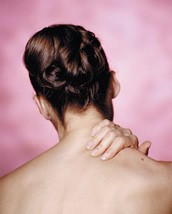Back and Neck Pain
The increased sedentary nature of our lifestyle has lead to a marked increase in the incidence of spinal pain. With a neck problem you could experience pain in your neck, shoulder, mid-back, arm or headaches. Likewise with a back problem you could experience pain in your back, groin, hip or leg.
These symptoms may be caused by an injury to any of the following:
- Discs – a prolapsed (slipped) disc can cause pain in your neck or shoulder, which may radiate as far as your hand.
- Muscles – with neck pain the muscles in the affected area can go into spasm (cramp). Poor posture especially when sitting for long periods can cause problems in the muscles of the neck and upper back.
- Joints – stiffness and degeneration of the spinal and sacro-iliac joints are common causes of low back pain.
- Ligaments – spinal ligaments sprains are generally caused by over-stretching or trauma such as a fall.
- Nerves – compression of a nerve such as the sciatic nerve can cause pain, pins and needles and numbness in your leg.
There are also certain syndromes associated with neck pain such as whiplash, jaw pain and headaches.
A visit to a Chartered Physiotherapist will start with a detailed assessment in order to identify the exact site of damage, the underlying cause and to plan a treatment program to suit your needs. This is achieved by taking a history of the problem, testing all the structures that may cause the symptoms and forming a diagnosis. The outcome of the assessment and the treatment program will be explained.
Specific treatment of spinal pain could include some of the following:
Manual Techniques
- Manual techniques –
manipulation or mobilisation to restore normal mobility and alignment of the
tissues.
- Posture correction.
- Soft tissue techniques – massage, frictions, trigger point therapy, acupressure and stretching.
- Therapeutic exercise – stretching and strengthening. To maintain good posture the muscles surrounding the spine must be of appropriate strength. To achieve this, your therapist may use techniques such as Pilates or the Alexander technique.
- Electrotherapy – ultrasound, interferential and laser speed up the rate of recovery of injured tissues and decrease pain. T.E.N.S. is used in treating chronic pain. Electrical stimulation of weak muscles may also be necessary to aid their recovery.
- Traction.
- Hydrotherapy.
- Biomechanical assessment and prescription of orthotics (customized insoles).
- Prescription and fitting of collars, pillows, spinal supports, lumbar rolls and corrective seating.
Your Chartered Physiotherapist will monitor your symptoms at each visit and will progress your treatment program accordingly. If appropriate, your physiotherapist will liaise with your doctor, hospital consultant or other health care professional. You will be advised on return to work, sport, daily activities, ergonomics (adapting your working environment to suit your needs), manual handling (correct lifting and handling techniques) and prevention of recurrence.
A Chartered Physiotherapist is a university graduate with hospital-based training who has comprehensive knowledge of how the body works and specialist training in the diagnosis and treatment of injuries.

